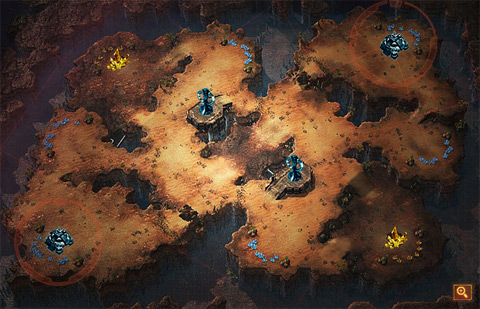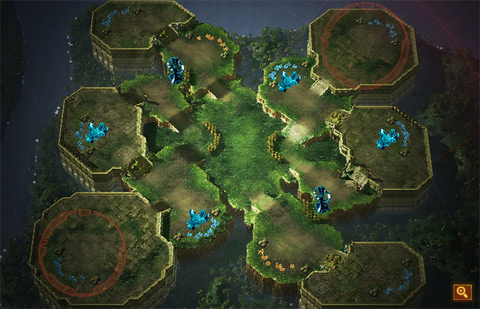
For Blistering Sands, the design team comments that "you definitely want to control the observatories. If you don’t, you must assume your opponent does and act accordingly."
The middle of the map has two observatories each on high ground with a ramp that points toward one of the two bases. "They are key contributors to map control and scouting, as they each grant vision over major avenues between the two bases," comments the design team.
The top left and the bottom right holds expansions with high yield minerals that gives more minerals than the regular blue. However, there are destrucible rocks that block their way. "Scout the high-yield expansions early with an eye toward grabbing them as soon as you feel you can afford it," is the design team's tip.

Steppes of War is smaller in size, which according to the design team lends itselfs to aggressive play and "low-tech" games. Two natural expansions for each base is available and can be defended at one position thanks to its layout.
Just like Blistering Sands, the map holds two observatories just below the second natural expansion area. "Similarly, the observatories serve a different purpose on this map. Rather than being used to scout the main avenues of attack, they help keep an eye on valuable high-yield expansions," says the design team.
Q&A session with the design team
StarCraft II Development Team: Essentially, we try to create 1v1 maps that don’t lean toward favoring defensive or aggressive play styles. We also want to make the maps fast-paced and dynamic, while also offering interesting tactical and strategic choices throughout the course of the game -- such as multiple paths of attack. We can look at Blistering Sands and Steppes of War as examples of this philosophy.
In Blistering Sands, for example, if you play aggressively, you put yourself in a better position to grab and hold a second expansion, since it’s open to attack from three sides and situated in a high-traffic area far from your natural expansion. In addition, if you manage to break the rocks guarding your opponent’s base, you open up the most direct means of attack.
To play defensively on Blistering Sands, you can take advantage of the fact that it’s relatively easy to defend your base’s natural expansion. You can also capitalize on the map’s relatively long ”rush distance,” which is the length of the ground path between the two bases, and the extremely far “air-to-air distance,” which is the actual distance between the two bases in a straight line.
On Steppes, the advantages of playing aggressively are the short rush distance, the lack of observatory support in the early game for the defending player, and the ability to control the open high-yield expansions that can significantly impact the outcome of the game. The advantages of playing defensively include the relative ease of defending your base, its two natural expansions, and -- if you can gain control of them -- the semi-island expansions in the corners.
Is it a challenge to design for the smaller map size used in 1v1?
Actually, the smaller map size of a 1v1 map is something we like in general in multiplayer maps -- we like to keep them as lean as possible. Keeping map sizes down translates into fast-paced gameplay with constant interaction and conflict among players, and it keeps scouting relevant and effective throughout the course of the game.
In addition, a map that is even slightly too large could cause scouting on that map to be more luck-based than strategic. However, a map that is too small favors rush strategies too heavily. A good-sized map allows for different strategies and styles of gameplay that use the whole map without favoring one strategy too strongly over another.
How does the design of a 1v1 map differ from other map types, such as a 6-player free-for-all map?
One way they’re different is that on smaller maps, early scouting isn’t emphasized as much as it is on larger maps, because you know exactly where the other guy is from the beginning. On larger maps, say a 6-player map, you spend a lot more time and effort scouting your opponents early on. However, that doesn’t mean you won't be scouting in a 1v1 map -- far from it. It just means your scouting will be based more on strategy, to see what your opponent is up to.
In general, scouting will be less luck-based in 1v1 than in other formats. However, this also leaves less margin for error, particularly in the early game. What you do to prepare for or how you execute an early rush becomes magnified in importance -- particularly in highly competitive games, where every second counts.
Another way 1v1 maps differ from other map types is that they generally have the most expansions per player. This is a result of the way that the original StarCraft’s 1v1 gameplay was shaped by certain 4-player maps that were heavily used for 1v1, such as Lost Temple, where players had many expansions available to them. We stay true to this tradition by making sure that StarCraft II’s dedicated 1v1 maps generally retain that high expansion-to-player ratio. By the way, those 4-player maps still exist in StarCraft II and can be used for 1v1, 2-vs.-2, and 4-player free-for-all, just as before.
In addition, designing for a specific format like 1v1 allows us to tailor a map in ways that take advantage of certain intrinsic qualities that wouldn’t make sense or don’t exist for different map formats. For example, since the starting locations on a 1v1 map are fixed, we can design multiple specific paths between the bases, each with their own advantages and disadvantages. By contrast, a 4-player map should have a more open layout. This kind of focused, customized approach can help create opportunities for players to make interesting and varied choices throughout the game.
What are some new additions or differences in the gameplay of StarCraft II that are reflected in the map design?
Some differences arise from the new units and their abilities. With new elements such as protoss warp-ins and the controllable terran supply depots, it’s easier to respond to rushes and attacks that you aren’t prepared for. In addition, the new cliff-walker units such as terran reapers and protoss colossi are able to disregard elevation differences to a degree. We have to take these new abilities into account when designing StarCraft II’s maps.
Terrain mods -- such as observatories, shrubs, and destructible rocks -- are new features of StarCraft II that we’re using frequently in our maps. In addition, StarCraft II makes improvements to existing terrain features such as ramps, which should help with unit pathing and other behaviors.
Another new addition is the increased importance and effectiveness of high ground. If you have the high ground and there are no enemy flyers in play, playing defense is much easier than an analogous situation in the original StarCraft. This is compounded by the extra level of terrain -- a fourth as opposed to the original’s three -- that exists in StarCraft II’s maps.
Last but not least, high-yield minerals add another new dynamic for players to consider. They have the same properties as normal mineral fields, except they return 40 percent more minerals per trip and generally have fewer nodes per expansion. A typical base tends to have around eight mineral patches, while high yields tend to have about six. This ultimately means that fewer workers are required to optimally harvest the six nodes, and the gains are greater in most situations where worker counts are not at maximum capacity.
This extra rate of income makes them highly attractive as expansions, as their influence can be game-changing. But we balance this by placing them in high-traffic areas that are hard to defend and easy to scout. You can see this practice in action on Steppes of War and Blistering Sands.
Also, check out a look-through on the Single player campaign, available in the links below.
Links
StarCraft2.com - Designing the 1on1 maps of StarCraft 2
StarCraft2.com - Single player storytelling: StarCraft II Wings of Liberty


![[Op-Ed] Women in competitive gaming – why are there so few?](https://static.gosugamers.net/8f/c9/2c/df69cf93db41c27a46978529e01614f38e0bfb80888132ac95fd3f89fb.jpg?w=1600)




